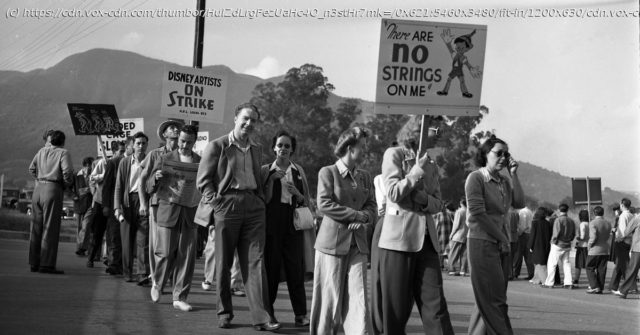The current WGA strike is just the latest pushback against studio exploitation. Here’s how the Disney animators’ strike of 1941 changed Hollywood.
The Writers Guild of America (WGA) has been on strike just shy of a month now, with no foreseeable end in sight. Motivated by a breakdown in negotiations with Hollywood studios over pensions, residual compensation for streaming productions, health care, and protections for writers rooms in the wake of AI, the WGA strike represents a fight, in the words of writer-comedian Adam Conover, “for the survival of television and film writing as a sustainable career.”
Disclosure: Rank-and-file staffers at Polygon are members of the Vox Media Union, which is affiliated with the Writers Guild of America, East (WGAE). The Vox Media Union’s collective bargaining agreement is separate from the Minimum Basic Agreement, the labor contract between screenwriters and television and film producers. The current labor dispute between the Alliance of Motion Picture and Television Producers and the Writers Guild of America (which consists of the WGAE and its sister union, the Writers Guild of America West) does not involve the newsroom unions that are affiliated with the WGAE.
This ongoing drama over the future of the American entertainment industry is just the latest in a long line of conflicts between collective labor and monopolized power. Given how inevitable those conflicts are, it’s worth looking back at how important they’ve been as well, in terms of shaping the current entertainment landscape. This week marks the 82nd anniversary of a game-changing strike at Walt Disney Animation Studios, one that sent shock waves throughout Hollywood and reshaped the American animation industry as we know it today.
The Disney animators’ strike of 1941 wasn’t the first strike of its kind: The Fleischer Studios strike of 1937 produced the industry’s first union contracts. But the Disney strike was a critical moment for the American labor movement. By 1941, every other major animation studio, including Warner Bros. and MGM, had already effectively unionized. Walt Disney Animation Studios’ holdout was one of the less flattering and lesser-known ways the company stood apart from Hollywood orthodoxy.
The strike may have been part of the spirit of the times, but it’s just as attributable to the company’s workplace culture throughout the 1930s, and to one event in particular. Ironically, it’s the same event that transformed Disney from a popular animated-shorts house into a cultural powerhouse: the production and theatrical release of 1937’s Snow White and the Seven Dwarfs.
The seeds of dissent at Disney were planted as early as spring of 1934, when studio founder Walt Disney first announced plans for his company’s most ambitious and challenging undertaking to date. Inspired by a formative experience as a kid in Kansas City, watching J. Searle Dawley’s 1916 film Snow White in theaters, Walt set out to produce the world’s first full-length cel-animated feature film, in color and with accompanying sound.
The three-year production of Snow White and the Seven Dwarfs was a massive undertaking, requiring 32 animators, 1,032 assistants, 107 inbetweeners, 10 layout artists, 25 background artists, 65 special effects animators, 158 inkers and painters, and countless other uncredited members of the production staff, according to the Walt Disney Family Museum website. The movie suffered significant delays: Its first completed animation was submitted to Disney’s ink and paint department on Jan. 4, 1937, less than a year before its premiere date.
In total, Snow White required 250,000 drawings to be animated, inked on celluloid animation frames, painted, and photographed — and that’s not counting the completed sequences Walt ultimately chose to cut from the final film. Inkers were expected to trace a minimum of 30 cels per day, while each painter was expected to complete 17 cels a day. In October 1937, the production staff was informed that, for Snow White to be ready by its premiere date, their regular work schedules would be extended from nine-hour workdays, five days a week, to 10-and-a-half-hour workdays, six days a week, with no paid overtime. Disney animators weren’t properly compensated for overtime work until the Fair Labor Standards Act of 1938 federally mandated overtime pay for employees working over 40 hours per week.
Home
United States
USA — software Walt Disney cheated his animators out of profits — and their strike...






